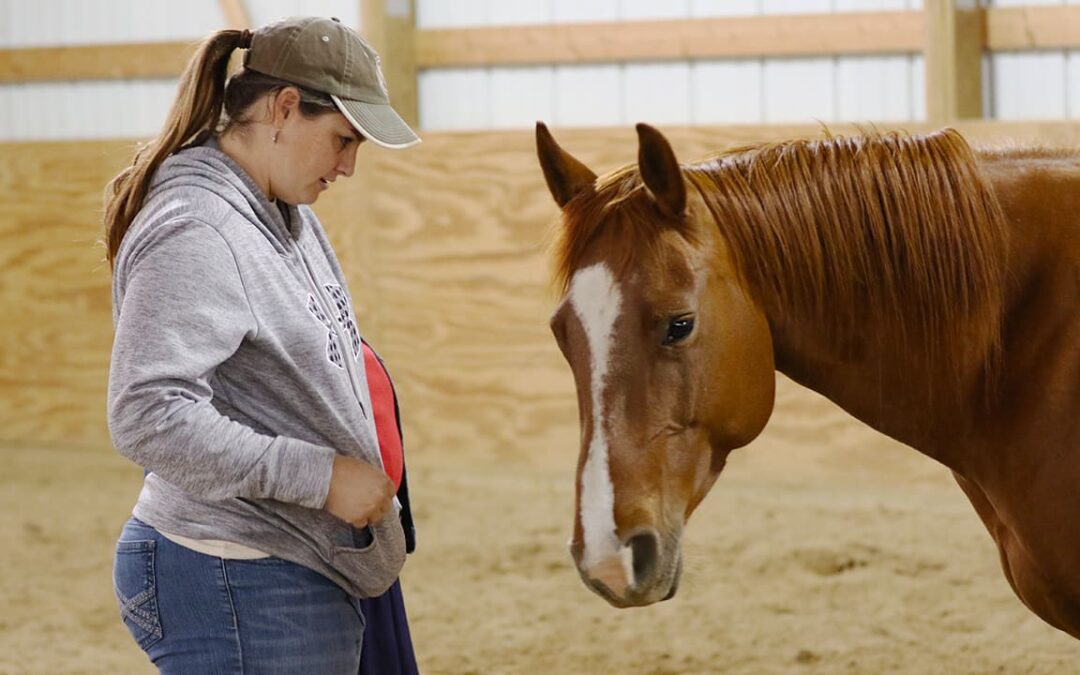Many equine professionals have a difficult time identifying the difference between compliance/ submission and cooperation in a horse.
This is an important skill to develop for your work in the Natural Lifemanship model, whether you are practicing TF-EAP, teaching riding lessons, training your horses, or coaching a client in professional or personal growth and development. If you’ve been to a Fundamentals of Natural Lifemanship training, you may recall your trainers talking about the difference between compliance and cooperation. You may have experienced the difference in your round-pen work with the horses at your training.
Neurobiologically, in both humans and horses, the difference between compliance and cooperation is dependent on which part of the brain the behavior or action is coming from. If the action is done out of alarm, fear, or terror, it is originating in the lower regions of the brain, and is, therefore, compliance (I can’t escape this pressure or fight it and remain safe, so I must submit to it in order to survive).
Remember that compliance is an adaptive survival response. Cooperation is a whole-brain resilient response. Cooperation happens when the lower regions of the brain are regulated and the higher regions of the brain are able to communicate and respond appropriately. The horse makes a choice to cooperate, rather than doing what you’ve requested because he feels he must to survive.
In order to help you identify when dissociation or compliance is happening with your horse in your TF-EAP sessions or with your work with him, I have compiled a list of 6 outward signs you can observe that may indicate your horse is complying, submitting, and dissociating. This is not an exhaustive list, and is not meant to stand alone.
Please don’t walk away from this list believing that any time a horse shows any of these signs, it means he’s dissociative. Use your, your mental health professional’s, and your client’s discernment in understanding what is happening in the horse within the context of the relationships at play. This list assumes observation of a horse in good physical condition with no known health problems (horses with chronic pain or health problems are likely to be dissociating from this pain on a regular basis).
1. Your horse’s body looks relaxed, eyes may even be softened and closed, but the jaw is tense and tight. He may show excessive licking and chewing, sometimes exaggerating these movements.
2. Right before the horse did what was requested, the horse was resisting (running or fighting) and began licking and chewing during the resistance right before he did what was requested. Imagine a horse running around a round pen when you are asking for attachment. He runs and runs, begins licking and chewing while running, then suddenly turns towards you and starts walking toward you. That’s compliance, not cooperation.
3. Your horse is complying with your request but is showing other signs of discomfort or tension such as: rapid breathing, wide eyes, whites of eyes showing, tightness in jaw, tightness around pole and ears, stiff and/or jerky movements, or head held very high with a tight neck.
4. Your horse does what you have asked, then as soon as the request or pressure is released, he moves away from you as quickly as he can.
5. Your horse does what you have asked, but when you change the request or change the pressure (increase or decrease) he doesn’t seem to notice. He may even appear to be falling asleep at this time.
6. Your horse quickly starts falling asleep while standing up to the point that he is losing balance, his knees are buckling, and he is falling to the ground, sometimes hitting his nose on the ground before he appears to notice what is happening. His knees buckle and he may even rest on his knees with his rear still up and eyes still closed for a few seconds before either falling all the way down or jerking his eyes open and head up before standing back up. This can look and feel like your horse has fainted or passed out.
This one is seen less often because it is a more extreme form of dissociation for a horse. In my experience, this can be a good indication that this horse has a very strong pattern of dissociation and had likely been acting in a state of compliance and submission long before you observed this behavior.
Reccia Jobe partners with therapists to offer TF-EAP. She also does equine assisted personal development and life coaching. For more information visit www.pecancreekeap.com
To learn more on this subject join us at Interconnected 2020 October 21st – 25th – a virtual conference hosted by Natural Lifemanship – and participate in the following workshops:
Hidden in Plain Sight: The Signs and Symptoms of Dissociation Parts 1-3
Consent and THIS Horse Parts 1-2



Recent Comments